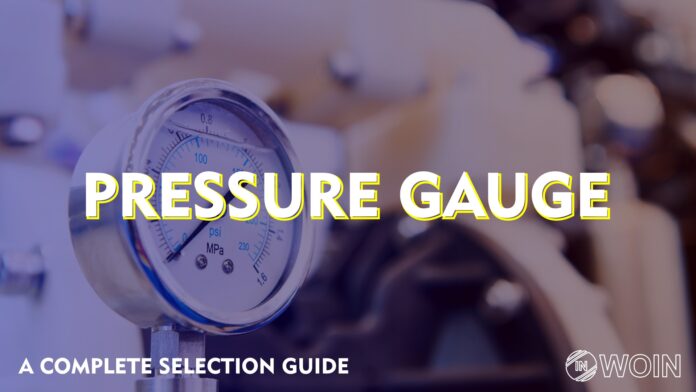Pressure Measurement is Very Important in Industry. In this article, I will give you complete information about the pressure gauge and its selection process.
Introduction
Pressure Gauges are very important Mechanical devices. It translates mechanical movement into Pressure Value.
Before we go into the selection process, we need to understand some basic concepts about Pressure Measures. As you all know Pressure is defined as a force per area.
Classification of Pressure
Before we start our article, we need to understand the types of Pressure we need to measure.
- Absolute Pressure
- Gauge Pressure
- Differential Pressure
- Vacuum Pressure
According to Types of Pressure, measuring gauges are selected accordingly. So, let’s understand the Types of pressure using Visual Representation.

As you can see, the above image represents what is the difference between Gauge Pressure, Absolute Pressure, Differential Pressure, and Vacuum Pressure.
People are mostly confused between Absolute Pressure and Gauge pressure. In simple language, the difference between Gauge and Absolute Pressure is Reference Pressure.
In Guage Pressure Atmospheric Pressure considers a reference ZERO and In Absolute Pressure, Absolute ZERO pressure Consider as a Reference ZERO.
Types of Pressure Gauges
There are many types of pressure gauges available in the market that are listed below.
- Diaphragm Seal Type
- Bourdon Tube
- Bellow Type
- Capsule Type
In this article, I only discussed the most commonly used Pressure Gauges in the industry.
- Diaphragm Seal Type
- Bourdon Tube Type
Steps of Pressure Gauge Selection
Step – 1 | Process Medium and Physicals Property of Medium
As you can see from the working principles of the Bourdon tube and Diaphragm Seal type pressure Gauge you will find out that the Bourdon Tube type pressure Gauge is directly in Contact with the Process Medium.
If the process medium is corrosive and highly reactive then we have to select Diaphragm seal type Pressure Gauge.
When we have to measure the Pressure of viscose fluid then we have to consider Diaphragm type Pressure Gauges.
Because Viscous fluid is stuck in Bourbon tube and leads to Measurement Errors and Frequent Maintenance.
Step – 2 | Pressure Range
When we have to select a pressure gauge for low-Pressure Measures then we have to select a Diaphragm type pressure Gauge. Diaphragm type pressure gauge is measured up to 10 mbar.
Step – 3 | Over Range Protection
If our measuring Pressure is unstable and sometimes fluctuates more than its maximum operating pressure Limit.
And application required higher over range protection then we have to choose a Diaphragm Seal type pressure gauge
Step – 4 | Cost
And finally, we have to consider the cost of equipment. So, the Bourdon tube type pressure gauge is cheaper than the diaphragm seal type pressure gauge.
Pressure Gauges Protection
Pressure Gauge protection is very improving because Breakage and cracking of PG leads to Leakage of the Process fluid and created Hazardous Conditions.
There are multiple types of protection techniques that are used for protecting Pressure Gauges.
- Fluid Filling
- Syphon
- Gauge Saver
Fluid Filing
The fluid filling is one type of Protection that protects the Pressure gauge from Mechanical Vibrations.
Because Mechanical Vibration Leads to Measurement error. Because Mechanical Vibration is caught by Mechanical Pointer available in Pressure Gauge.
And Fluid Filling is Also protect Gauges from Mechanical failure due to mechanical vibration.
Syphone
It is a clever mechanism to protect pressure Gauges from sudden pressure and temperature changes.

Gauge Saver
Gauge Saver is a protecting device that protects gauges from overpressure.

Standards in Pressures Gauge
There are multiple standards available for Pressure Gauges that the industry needs to follow.
List of Pressure Gauge Standard
| Sr No. | Standard Number | Standard Name |
|---|---|---|
| 1 | BS EN 875-1 | Bourdon tube pressure gauges |
| 2 | BS EN 875-2 | Selection and installation recommendations for pressure gauges |
| 3 | BS EN 875-3 | Diaphragm and capsule pressure gauges |
Accuracy Class of Pressure Gauge
| No. | Accuracy Class | Accuracy classes Limits of the permissible error (Percentage of span) |
|---|---|---|
| 1 | 0,6 | ± 0,6 % |
| 2 | 1 | ± 1 % |
| 3 | 1,6 | ± 1,6 % |
| 4 | 2,5 | ± 2,5 % |
| 5 | 4 | ± 4 % |
How are Bourdon-type pressure Gauges made?
EndNote: –
I think now you have a better idea about pressure gauges and their selection process. If you still have any questions then comment below, and I will help you.
If you like this Article then you also like our previous article on Temperature gauges | Complete selection guide of temperature Gauge.


